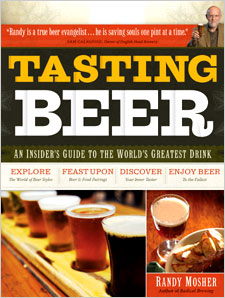 At the end of the Preface to “Tasting Beer,” right before you head to Page One, there’s a picture of a glass of beer with a command: “Don’t even consider starting this book without a beer in hand.”
At the end of the Preface to “Tasting Beer,” right before you head to Page One, there’s a picture of a glass of beer with a command: “Don’t even consider starting this book without a beer in hand.”
Since you have the book in the other hand you probably aren’t going to ask yourself if, since you are already drinking a beer you like, you really need this book. So I will. Do you think more knowledge about beer will make that beer taste better? If you answered yes then you should own this book.
(Before going on, a bit of a disclaimer. Author Randy Mosher and I are friends, and he asked me to to the “technical edit” of the book. Yes, that sounds as laughable to me as it must to you; like Malcom Gladwell calling me up to ask for story ideas. I don’t get any royalties from the book, so there is no incentive for me to give it a review that boost sales. Because I don’t know of another beer book to be published in 2009 that should be of as much interest to you I’m going to write about it.)
I thought about “Tasting Beer,” but wasn’t ready to write this review, when I posted “The tyranny of the tasting note” last month. Quite honestly, there’s more here than many of you are going to want. Perhaps you don’t feel the need to be able to turn to your dining companion and whisper, “I believe I’m getting a touch of autolysed yeast.” More than you might want now, that is, since once you head down the road of beer knowledge stopping ain’t easy. Because everything in this book is presented in easy to bite off chunks you can grab what you want now and come back later for more.
Mosher makes it deceptively easy. Consider this: “Every sensation found in a glass of beer has its origins in the decisions of the brewer and malstster made druing its manufacture. For instance, the tangy, green perfume of hops? That’s the result of the careful choice and deployment of prized aroma hops in the brewhouse or perhaps the fermenter. The light nuttiness and hints of raisiny fruit? That lightly kilned pale ale malt and a dab of crystal. And all of this is shaped by the mysterious workings of a particular strain of yeast under certain conditions.”
Whether that looks terribly simple to you or densely confusing it will all be clearer 27 pages later in a chapter called “Brewing and the Vocabulary of Beer Flavor.” You’ll be ready for “The Qualities of Beer” and looking forward to it.
I hate quoting book covers, but I’m going to point out that the subtitle for the book is, “An Insider’s Guide to the World’s Greatest Drink.” That’s certainly true, but you exit knowing you don’t have to be an insider to enjoy the beers Mosher writes about. Further, the back cover claims “Tasting Beer” is “The Portable Beer Expert.” Indeed.
Still with me? Then you’ve reached the part of the review where the reviewer offers a profound thought. I’ll pass and give the author the final word:
“Beer is only as good as the people who seek it out, support it, keep it honest, and, most important of all, enjoy the genuine pleasures of it.”
—————————————–
– Order from BeerBooks.com (and support a business that cares as much about beer as you do).
– Order from Amazon.com.
Or drive to the bookstore and buy it right now.
